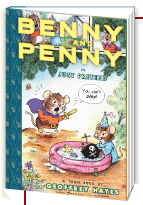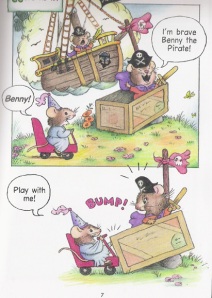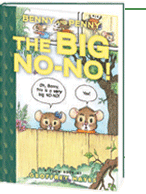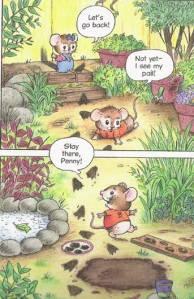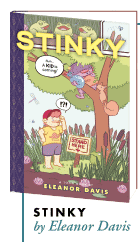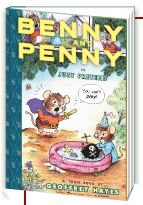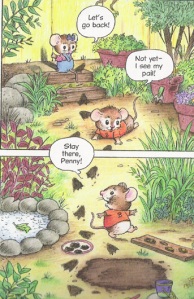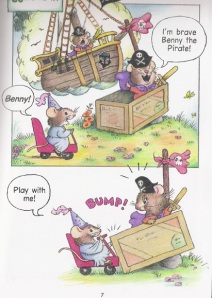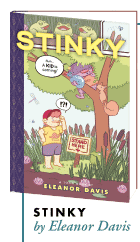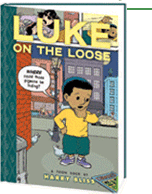 Nursery Rhyme Comics
Nursery Rhyme Comics
Edited by Chris Duffy
Introduction by Leonard S. Marcus
$18.99
ISBN: 978-1-59643-600-8
Ages 9-12
On shelves October 11, 2011
Nursery rhymes. What’s up with that? (I feel like a stand up comedian when I put it that way). They’re ubiquitous but nonsensical. Culturally relevant but often of unknown origins. Children’s literary scholar Leonard Marcus ponders the amazing shelf life of nursery rhymes himself and comes up with some answers. Why is it that they last as long as they do in the public consciousness? Marcus speculates that “the old-chestnut rhymes that beguile in part by sounding so emphatically clear about themselves while in fact leaving almost everything to our imagination” leave themselves open to interpretation. And who better to do a little interpreting than cartoonists? Including as many variegated styles as could be conceivably collected in a single 128-page book, editor Chris Duffy plucks from the cream of the children’s graphic novel crop (and beyond!) to create a collection so packed with detail and delight that you’ll find yourself flipping to the beginning to read it all over again after you’re done. Mind you, I wouldn’t go handing this to a three-year-old any time soon, but for a certain kind of child, this crazy little concoction is going to just the right bit of weirdness they require.
 Fifty artists are handed a nursery rhyme apiece. The goal? Illustrate said poem. Give it a bit of flair. Put in a plot if you have to. So it is that a breed of all new comics, those of the nursery ilk, fill this book. Here at last you can see David Macaulay bring his architectural genius to “London Bridge is Falling Down” or Roz Chast give “There Was a Crooked Man” a positive spin. Leonard Marcus offers an introduction giving credence to this all new coming together of text and image while in the back of the book editor Chris Duffy discusses the rhymes’ history and meaning. And as he says in the end, “We’re just letting history take its course.”
Fifty artists are handed a nursery rhyme apiece. The goal? Illustrate said poem. Give it a bit of flair. Put in a plot if you have to. So it is that a breed of all new comics, those of the nursery ilk, fill this book. Here at last you can see David Macaulay bring his architectural genius to “London Bridge is Falling Down” or Roz Chast give “There Was a Crooked Man” a positive spin. Leonard Marcus offers an introduction giving credence to this all new coming together of text and image while in the back of the book editor Chris Duffy discusses the rhymes’ history and meaning. And as he says in the end, “We’re just letting history take its course.”
In the interest of public scrutiny, the complete list of artists on this book consists of Nick Abadzis, Andrew Arnold, Kate Beaton, Vera Brosgol, Nick Bruel, Scott Campbell, Lilli Carre, Roz Chast, JP Coovert, Jordan Crane, Rebecca Dart, Eleanor Davis, Vanessa Davis, Theo Ellsworth, Matt Forsythe, Jules Feiffer, Bob Flynn, Alexis Frederick-Frost, Ben Hatke, Gilbert Hernandez, Jaime Hernandez, Lucy Knisley, David Macaulay, Mark Martin, Patrick McDonnell, Mike Mignola, Tony Millionaire, Tao Nyeu, George O’Connor, Mo Oh, Eric Orchard, Laura Park, Cyril Pedrosa, Lark Pien, Aaron Renier, Dave Roman, Marc Rosenthal, Stan Sakai, Richard Sala, Mark Siegel, James Sturm, Raina Telgemeier, Craig Thompson, Richard Thompson, Sara Varon, Jen Wang, Drew Weing, Gahan Wilson, Gene Luen Yang, and Stephanie Yue (whew!). And as with any collection, some of the inclusions are going to be stronger than others. Generally speaking if fifty people do something, some of them are going to have a better grasp on the process than others. That said, only a few of these versions didn’t do it for me. At worst the versions were mediocre. At best they went in a new direction with their mat



